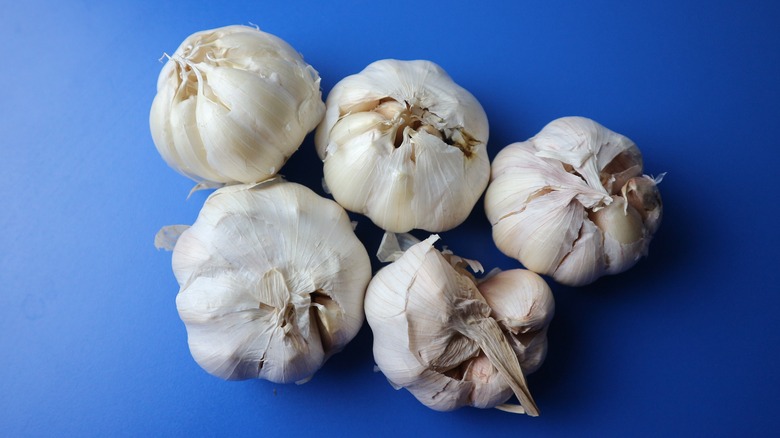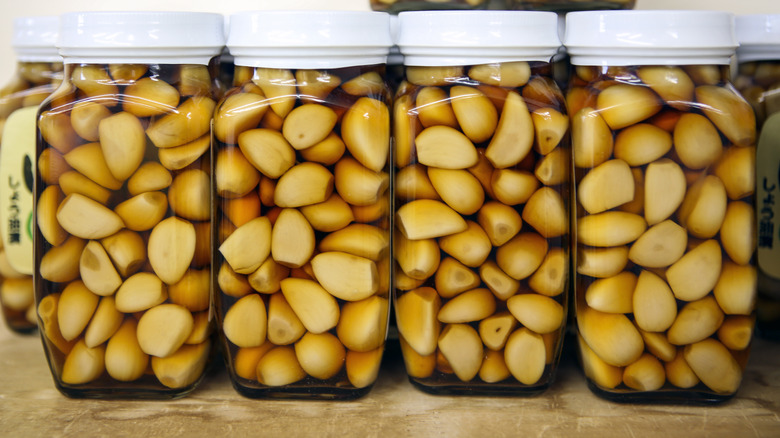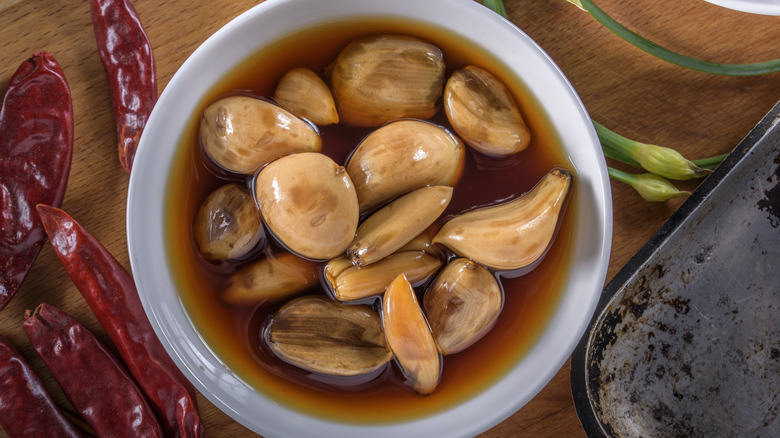The Reason Your Pickled Garlic Turned Out Blue
What does it mean if your garlic ends up with a bluish hue? Do you have to throw it out? Fortunately, blue garlic is a totally normal effect of the pickling process. The color change occurs due to a few chemical reactions garlic undergoes when it's manipulated. Garlic contains several similarly named chemicals, including a sulfur compound called alliin and an enzyme called alliinase, which helps transform alliin into allicin. Once allicin is activated, garlic takes on its singular smell and taste. Allicin is also responsible for that weird blue color — it emerges when allicin meets an acid, like the vinegar essential for pickling.
All that this process changes is the garlic's color. Blue garlic can still be safely eaten and will retain the vegetable's typical flavor. If you'd like to keep this from happening, though, be careful about the water, salt, and cookware you use during pickling.
The chemistry that turns pickled garlic blue
A garlic bulb is a science experiment waiting to happen. When you manipulate a garlic clove by cutting or grating it, the aforementioned alliin and alliinase combine to produce allicin. You know how your kitchen fills with the smell of garlic before you even put it in a pan? That's activated by the creation of allicin. The more you work with the garlic, the more allicin is released, so the odor and eventual flavor just get stronger. That said, it is possible for garlic to smell too strong. If the bulb has a sprout of three inches or more, that's when garlic should be thrown out, as sprouted garlic can make your food taste bad. The sprout leeches sugar from the clove as it grows, which can turn the garlic bitter.
When allicin meets an acid, it causes yet another reaction. The vinegar traditionally used in the pickling process is acidic, so it prompts allicin to create chains of polypyrroles. These are grouped rings of carbon-nitrogen combos which affect coloring. Different amounts of polypyrroles generate different-colored rings, and three is the magic number for blue rings in your garlic.
How to keep pickled garlic from turning blue
There are a few simple steps you can take to keep your next batch of pickled garlic from turning blue. First off, older garlic doesn't just taste bitter — as garlic ages, it harbors more and more sulfur components like alliin, which makes it more susceptible to color-changing chemical reactions. Use young, fresh garlic as a preventative measure.
Before pickling, it's recommended to blanch the garlic cloves. Blanching involves partially cooking food by briefly placing it in boiling water and then immediately moving it to ice water. Think of it as a polar plunge for the garlic. The blanching process helps set the garlic's color by stopping enzyme breakdowns, thereby restraining allicin from running wild.
When you're ready to start pickling, be sure to use both distilled water and iodine-free salt. Tap water and iodized salt each introduce trace metals to the garlic, which could react with the natural sulfur within. Copper is a prime offender here, which also means it's a good idea to avoid cooking pots, pans, and utensils that contain it or other metals. Stainless steel cookware is safe to use here.
Lastly, keep pickled garlic jars out of direct sunlight. Think back to science class here; plants in the sun generate chlorophyll, which gives leaves green coloring. The same principle applies to the garlic on your windowsill. With the comfort that your garlic won't look odd, branch out with fun recipes like lemon pickled garlic for a deliciously bold flavor.


